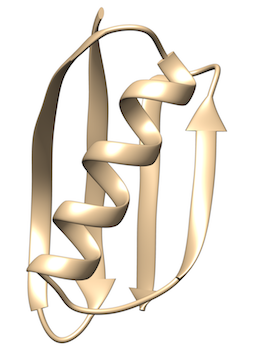The aim of this tutorial is to train users to learn the syntax of complex collective variables and use them to analyze MD trajectories of realistic biological systems and bias them with metadynamics.
Once this tutorial is completed students will be able to:
The TARBALL for this tutorial contains the following files:
In this tutorial we propose exercises on the protein G B1 domain described using a structure-based potential obtained using SMOG (smog-server.org)
GB1 is a small protein domain with a simple beta-alpha-beta fold. It is a well studied protein that folds on the millisecond time scale. Here we use a structure based potential and well-tempered metadynamics to study the free energy of folding and unfolding. In the TARBALL of this exercise we provide the files needed to run the simulation, the user should write the plumed input file needed to bias the sampling.

The users are expected to:
The users are free to choose his/her favorite CVs and they are encouraged to use the on-line manual to create their own PLUMED input file. However, we encourage all the users to experiment at least with the following CVs to characterize the free-energy landscape of GB1:
Unfortunately secondary structure collective variables cannot be used in this case because the model does not include hydrogen atoms.
The users should first perform a preliminary simulations and use this to select one or more CV to be later employed for a METAD or RESTRAINT (umbrella sampling) simulation. Once you are satisfied by the convergence of your simulation, you can use one of the reweighting algorithms proposed to evaluate the free-energy difference between folded and unfolded state as a function of multiple collective variables.
#SETTINGS MOLFILE=user-doc/tutorials/lugano-6d/GB1_native.pdb #this allows you to use short-cut for dihedral angles MOLINFO STRUCTURE=GB1_native.pdb #add here the collective variables you want to bias #add here the RESTRAINT or METAD bias, remember that for METAD you need to set: one SIGMA per CV, one single HEIGHT, one BIASFACTOR and one PACE. #Using GRIDS can increase the performances, so set a as many GRID_MIN and GRID_MAX as the number of CVs with reasonable ranges #(i.e an RMSD will range between 0 and 3, while ALPHABETA and DIHCOR will range between 0 and N of dihedrals). #add here the printing and/or other analyssi
In summary, in this tutorial you should have learned how to use PLUMED to: